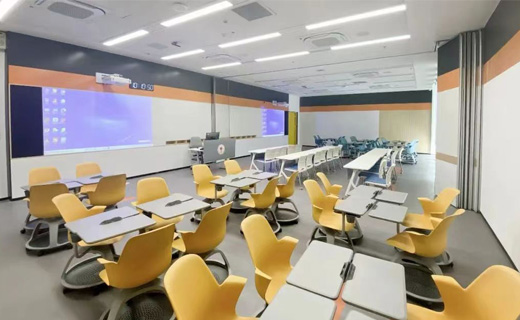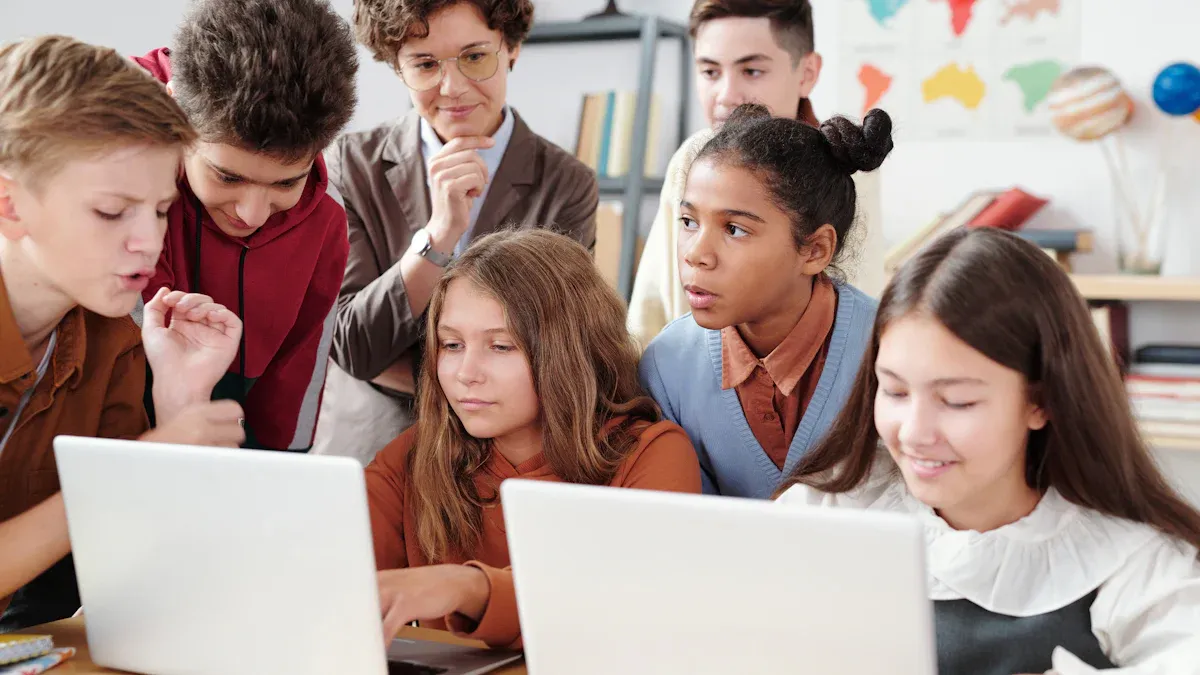
A digital classroom is a technology-driven learning environment that makes education more engaging and effective. It uses tools like virtual assistants and data analytics to support teachers and students. For instance, virtual assistants provide personalized guidance, reducing missed assignments by 43% and increasing parent engagement by 37%. These innovations help you learn better and stay more connected.
Digital classrooms use technology to make learning fun and personal.
Students can learn anytime, anywhere, and at their own speed.
Teachers use data to find students needing help, improving learning.

A digital classroom is a modern learning environment where technology plays a central role in education. It uses tools like interactive software, smart devices, and artificial intelligence to create a more engaging and effective experience for you. The purpose of a digital classroom is to make learning accessible, personalized, and data-driven. It helps teachers focus on teaching by automating tasks like grading and managing data. This allows them to spend more time interacting with you and addressing your needs.
In a digital classroom, smart content makes learning materials easier to access. AI-powered tools, such as virtual tutors, provide personalized instruction to help you understand concepts better. Schools also use data to improve teaching methods and help you set learning goals. For example, educators can track your progress and adjust lessons to match your pace.
A digital classroom has several features that make it unique:
Interactive Tools: You can use devices like tablets, laptops, or smartboards to participate in lessons actively.
Personalized Learning: AI tools adapt lessons to your strengths and weaknesses, helping you learn at your own pace.
Data-Driven Insights: Teachers use data to predict which students might need extra help. This approach has an 85% accuracy rate in identifying at-risk students, according to the University of Michigan.
Improved Outcomes: Schools using digital classrooms report a 12% increase in graduation rates and a 30% reduction in dropout rates.
Statistic Description | Value | Source |
|---|---|---|
Accuracy in Predicting At-Risk Students | 85% | University of Michigan (Arnold & Pistilli) |
Increase in Graduation Rates | 12% | Georgia State University (Dimeo, 2017) |
Reduction in Dropout Rates | 30% | Arizona State University (Kamenetz, 2016) |
These features ensure that a digital classroom not only enhances your learning experience but also improves overall educational outcomes.
A digital classroom relies on several key components to create an effective learning environment. First, devices like laptops, tablets, and interactive whiteboards serve as essential tools for both students and teachers. These devices allow you to access lessons, complete assignments, and collaborate with classmates. The student-to-computer ratio has significantly improved, moving from 7:1 in 2012 to nearly 1.5:1 in 2022, according to the OECD. This ensures that more students have access to the technology they need.
Second, software platforms play a critical role. Learning management systems (LMS) help organize course materials, track progress, and provide feedback. Teachers use these platforms daily, with 65% of them incorporating digital tools into their lessons, as reported by Gallup. Additionally, EdTech platforms have seen a 92% increase in usage between March 2020 and March 2021, highlighting their growing importance.
Finally, infrastructure like high-speed internet and cloud storage supports seamless communication and data sharing. These components work together to make the digital classroom a dynamic and efficient space for learning.
Evidence Type | Statistic/Impact |
|---|---|
Student-to-Computer Ratio | Improved from 7:1 in 2012 to nearly 1.5:1 in 2022 (OECD, 2022) |
Teacher Usage of Digital Tools | 65% of teachers use digital learning tools daily (Gallup and NewSchools Venture Fund, 2021) |
EdTech Adoption Increase | 92% increase in EdTech platform usage between March 2020 and March 2021 (UNESCO, 2022) |
Technology transforms how you learn by making lessons more interactive and engaging. For example, interactive software and gamified learning tools increase student engagement by 55%, according to the Gallup Student Poll. These tools encourage you to participate actively in lessons, making learning more enjoyable.
Collaboration becomes easier with digital tools. You can work on group projects with classmates, even if you're in different locations. Technology also supports inclusion by providing resources for students with special needs. For instance, text-to-speech software and visual aids help everyone participate fully.
Technology personalizes your learning experience. It adapts lessons to your pace and style, ensuring you understand concepts better. It also automates tasks like grading, giving teachers more time to focus on teaching. By using technology, you develop skills that prepare you for future careers in a tech-driven world.
Increased Student Engagement: Interactive tools boost participation and interest.
Collaboration: Digital platforms make teamwork more accessible.
Inclusion: Special tools help students with unique needs.
Differentiation: Resources cater to individual learning styles.
Productivity: Technology saves time and organizes materials efficiently.
Creativity: Digital tools encourage innovative thinking.
Automation: Routine tasks are handled by technology.
Future Focus: Prepares you for tech-based job markets.
A digital classroom makes learning accessible to everyone, no matter where you are. You can join lessons from home, a library, or even while traveling. Online platforms and user-friendly apps allow you to participate using your personal devices. This flexibility removes barriers like location and time, making it easier for you to stay engaged in your studies.
For example, a systematic review shows that online learning enhances accessibility by letting students connect from any location. This means you can learn at your own pace and schedule, which is especially helpful if you have other commitments. With fewer restrictions, you can focus on achieving your educational goals.
Digital classrooms use technology to make learning more interactive and exciting. Tools like gamified lessons and blended learning approaches encourage you to participate actively. Studies reveal that students in blended learning environments perform better and find lessons more effective than traditional methods. Increased interaction opportunities also boost engagement, helping you stay motivated.
In fact, research shows that 71% of college students believe social media integration improves their learning experience. Participation rates rise by 34% when structured discussions are part of the curriculum. These tools not only make lessons enjoyable but also help you retain information better.
Study Focus | Findings |
|---|---|
Blended Learning | Students perform better and perceive learning as more effective. |
Engagement | Interaction opportunities enhance student engagement. |
A digital classroom tailors lessons to your unique needs. Adaptive technologies adjust the content based on your strengths and weaknesses, ensuring you learn at your own pace. Personalized learning boosts your motivation and understanding, making the process more enjoyable.
Studies highlight that personalized approaches improve student achievement more effectively than traditional methods. For example, individualized literacy instruction significantly enhances reading outcomes. These methods maximize your satisfaction and help you achieve better results in less time.
Personalized learning enhances motivation and engagement.
Adaptive technologies improve learning efficiency and effectiveness.
Individualized instruction leads to better academic outcomes.
By focusing on your specific needs, digital classrooms create a learning experience that works best for you.

Digital classrooms and traditional classrooms differ in several ways. The most noticeable difference lies in how lessons are delivered. Digital classrooms rely on technology, such as online platforms and interactive tools, while traditional classrooms focus on face-to-face teaching. This shift in delivery methods impacts how you engage with lessons and interact with teachers.
Research highlights some key contrasts:
Students in flipped classrooms, a type of digital learning environment, report higher satisfaction compared to those in traditional classrooms.
Engagement levels are significantly higher in flipped classrooms.
However, students in traditional classrooms often feel more comfortable due to the familiar structure of in-person learning.
Statistic Description | Digital Classrooms | Traditional Classrooms |
|---|---|---|
Student Preference | 31% prefer in-person classes | |
Retention Rates | 25% to 60% improvement | N/A |
Student Satisfaction | 70% feel online is superior | N/A |
Grade Improvement | 80% attribute improvements to online courses | N/A |
Learning Time Reduction | 40% to 60% less time needed | N/A |
These differences show how each environment caters to unique learning needs and preferences.
Digital classrooms offer several advantages. They provide flexibility, allowing you to learn from anywhere and at your own pace. They also save time, with studies showing a 40% to 60% reduction in learning time compared to traditional methods. Additionally, digital tools improve engagement and retention, helping you achieve better grades.
However, digital classrooms come with challenges. Some students may feel overwhelmed by the variety of learning activities. Access to reliable internet and devices can also be a barrier for some learners.
Traditional classrooms, on the other hand, provide a structured environment that many students find comforting. Face-to-face interaction fosters a sense of community and allows for immediate feedback. Yet, they lack the flexibility and personalized learning opportunities that digital classrooms offer.
Both classroom types have their strengths and weaknesses. Choosing the right one depends on your learning style and needs.
A digital classroom transforms how you learn by combining technology with education. It offers flexibility, personalized learning, and improved engagement. These advancements have the power to revolutionize education, making it more accessible and effective. As technology evolves, you can expect even more innovative tools to shape the future of learning.